by Dorothea
Burstyn
(click on photos to enlarge image)
DEUTSCHES KLINGENMUSEUM SOLINGEN
2009 flatware collectors meeting
The Solingen "14th convention of cutlery collectors and
friends of table culture" took place at the Solingen
Klingenmuseum on March 15th, 2009. The museum is located in
Gräfrath, a quaint little town with cobblestones throughout,
steep stairs up to a baroque church, charming little inns and a
four star hotel - the Gräfratherhof, where one can spend the
night for just Euro 65.00.
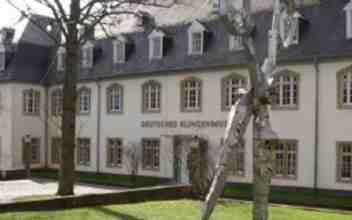 |
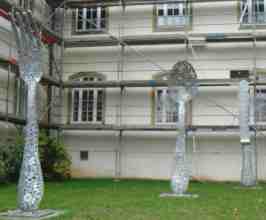 |
The Deutsches Klingenmuseum, Solingen
|
Giant spoon, fork and knife in the backyard
of the Solingen Klingenmuseum
|
The Klingenmuseum is a museum totally dedicated to
flatware and cutlery, as the fabrication of knives
was the main Solingen industry for centuries. Next
to displays of a grand dinner table (Fig. 3) and
historic flatware (the museum has a collection of
over 400 Art Nouveau flatware patterns), it houses
the marvelous Marquardt collection of European
knives, forks and spoons and the Pott Archives,
which feature all models fabricated by Pott from
1904 to 2005 thus giving an excellent picture about
this important flatware manufacturer.
This year convention participants were also treated
to a special exhibition: "zu Gast - 4000 Jahre
Gastlichkeit/ 4000 years of hospitality".
For more information about the Solingen
Klingenmuseum, please consult their excellent
website.
|
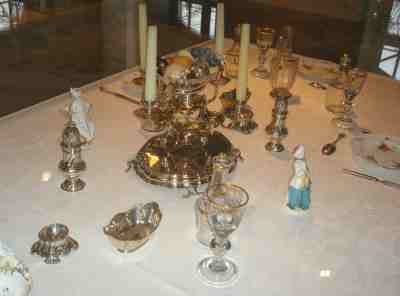 |
|
Display of an elegant dinner table appointed
with 18th century
silver and porcelain
|
The main program of the convention consisted of interesting
lectures.
Dr. RAINER LIEBENBERG spoke about his work as CEO of
silver manufacturer Reiner and the constant problems his
industry faces in a time of lessened demand and ever increasing
costs. Reiner has bought many dies and models from bankrupt
silver manufacturers such as Bruckmann, H.J. Rückert and others.
Traditional as well as artist designed flatware patterns are
still on the production program of this firm. Twice a year
Reiner takes orders for these obsolete patterns. The most known
patterns are "Atelier", which was ordered for the German Embassy
in Washington and "deSign", designed by Rudolf Elser in 1961
originally called "Sterling".
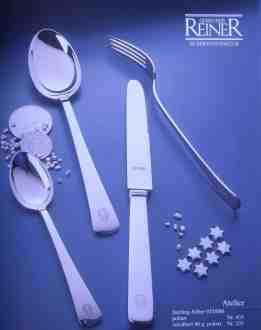 |
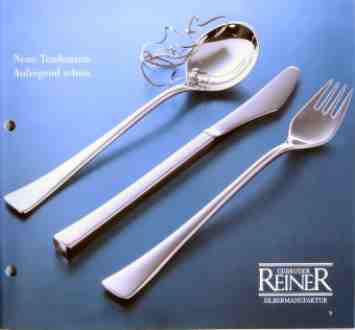 |
"Atelier" by Gebrüder Reiner Silbermanufaktur
|
"deSign" by Reiner
|
HEINRICH AVERWERSER held a most interesting lecture
about German Cutlery Design 1960-1970. (It should be noted that
English and German authors use the word cutlery not only for
knives but for flatware in general). His lecture was illustrated
with a comprehensive exhibition of German flatware, which
complemented a special exhibition of the Klingenmuseum’s
extensive collection of post WWII flatware. Mr. Averwerser has
written a book about the subject, titled: Besteckdesign in
Deutschland 1960- 1970, it costs Euro 40.00 and is available by
contacting the author by email: heinrich@averwerser.de
The book features many illustrations of the most important
flatware designs of this period and illustrations of the marks
used, plus an index of contemporary flatware designers, which is
referenced to the flatware illustrations.
Right after the war German flatware manufacturers produced
mainly 1930’s designs, as the cost for developing new dies and
models was prohibitive. This changed radically by the middle of
the Fifties, when production of new styles was taken up. Between
1960 and 1970 about 350 new designs from West and East Germany
came on the market -the new flatware designs were about the size
of the old "Menübestecke" (luncheon size), the knife blade was
reduced by about 1 1/4” (3cm), the knife handles got longer, the
traditional egg-shape of the spoon bowl got more oval or
rhomboid, the fork tines were shortened and the space between
tines and handle more dished. The nomenclature for the new
flatware size was not uniform, as some manufacturers speak of
"Tafel" and "Dessert"size (dinner and dessert size) without
giving exact measurements, others like Reiner silver
manufacturer speak of "Tafel" (dinner) and "Menü" (luncheon)
give measurements (the "Menü" knife measures 21-22 cm).
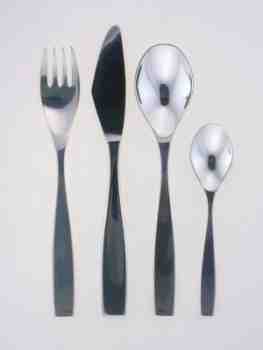 |
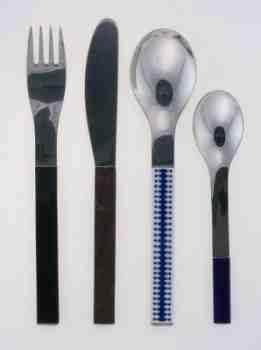 |
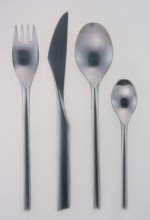 |
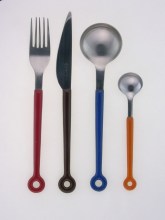 |
Rosenthal, Richard Latham,
2000, before 1964
|
Rosenthal, Carl Auböck,
Duo, 1966
|
Rosenthal, T. Wirkkala,
Composition, 1960
|
Seibel - Gebr. Raacke,
Monoring, 1962
|
In the early Fifties a lot of designs still featured
detailed decoration; the Sixties - strongly influenced by the
"Scandinavian style" - saw a domination of very plain patterns.
The style was popularized by traveling exhibitions like "The
Arts of Denmark"and "Scandinavian Design for Living". Flatware
now embraced form and material as the two main design
ingredients. Typical German patterns in Scandinavian style are
"Florida" by Wirths, "Landhaus" by Wüsthof or "Helsinki" by WMF.
In the early Sixties the majority of patterns were plain lacking
any decoration. This changed towards the end of the Sixties.
Several manufacturers now introduced patterns featuring all over
decoration to the market - Bruckmann’s "petitefleur"is one such
example. These should not be seen as a revival of old pre-war
patterns, but as an attempt to renew interest in flatware and
building up of new markets. New materials for handles were also
introduced: bamboo, teak, palisander, ebony but also porcelain,
plastics and aluminiumoxid-ceramic. Today the use of these new
materials would be unthinkable, as they are all not
dishwasher-safe -but in the 1960s dishwashers were not a
standard item in German kitchens, even in 1983 only 23% of
German households were equipped with dishwashers.
By the late Sixties first signs of market saturation were
noticed, an additional threat for the industry was the increased
competition of imported flatware from Japan. 1962 Japanese
products had about 50% of the German market share, in 1963 an
agreement about import limitation between Germany and Japan was
reached, but proofed ineffective as by 1967 90% of all flatware
sold in Germany came from Japan. The Japanese use of the
monobloc-knife – a knife made in one piece and not with an
expensive set-in steel blade - allowed for the much cheaper
production of flatware. The closing of German flatware
manufacturer firms was the logical consequence. The German
industry now specialized in high quality products for specific
uses - party and picnic flatware, - the "Mijoli"
(Milk/yoghurt/lemonade), a long spoon offered in a set of two is
a typical example. Rosenthal introduced a new concept of table
designs which included matched porcelain, glasses and flatware.
Rosenthal used designs of famous designers like Tapio Wirkkala
and Wolf Karnagel. Another successful enterprise was a
partnership of Mr. Arthur Salm and Mr. Henkels. The firm was
named Salm & Henkels. Salm worked in Chicago on the promotion
and sales of the S&H products while Henkels – stationed in
Solingen - was finding cheap production places for their
flatware. Their flatware is often stamped with "AS. Austria" and
similar generic marks; the real manufacturers of these wares
remain unknown. The Salm & Henkels production program also
included hollowware, which mostly imitated styles produced by
Dansk Design. But on the whole -despite all attempts of creating
innovative products and finding new marketing concepts - the
German flatware industry was doomed by the late 1970s.
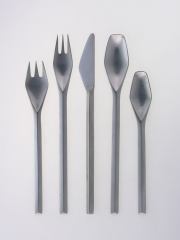 |
 |
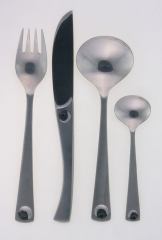 |
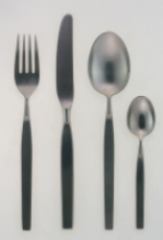 |
Englert & Solvie, Mettmann, Hans K.
Rodenkirchen, Partybesteck, 1962
|
Mijoli-spoon, before 1966, unknown designer,
J.A.Henckels, Solingen
|
Rosenthal, Wolf Karnagel,
Plus, before 1970
|
WMF, Irving Harper,
Orion, before 1970
|
BARBARA and BILL BROWN, the eminent flatware
collectors and dealers from London/England made a special
presentation and exhibition of porcelain handled cutlery which
featured rare and fabulous eighteenth century examples. By the
way the Browns are moving their stand in Portobello Market to
the Delphin arcade.
Many dealers exhibit their wares at the convention
and one can find there amazingly rare items and has
a chance to chat with very knowledgeable dealers.
The lunch, hosted by the Solingen Klingenmuseum,
gives a further chance to socialize and get to meet
fellow collectors from many different countries.
Dr. BARBARA GROTKAMP-SCHEPERS, the very
friendly and able director of the museum, is making
sure that everyone has a good time and should be
congratulated to organize this convention every year.
The Solingen flatware collectors meeting is surely
an event which should be put into the calendar of
every flatware collector.
|
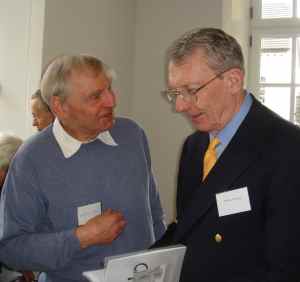 |
| |
Dr. Hood in conversation with Wilfried Moll,
having just bought a set of Robbe & Berking newest
pattern "Sphinx", he was very delighted to meet the
designer in person at the Solingen convention
|
I would like to thank Mr. Averwerser for his many emails
sharing information and supplying the illustrations of German
flatware from 1960-70. All Reiner flatware illustrations
courtesy of Gebrüder Reiner Silbermanufaktur.
BIBLIOGRAPHIY
- Heinrich Averwerser: Besteckdesign in Deutschland 1960-1970
Ausstellungskatalog im Deutschen Klingenmuseum in Solingen
mit Bestecken aus der Sammlung Heinrich Averwerser, Burgdorf,
2009
- Wolfgang-Otto Bauer: Europäisches Besteck-Design, Modern
European Cutlery Design 1948-2000, The Bauer Design Collection,
Stuttgart 2007, Arnoldsche Art Publishers
- Barbara Grotkamp-Schepers/Reinhard W. Sänger: Bestecke des
Jugendstils/Art Nouveau Knives, Forks and Spoons,
Bestandskatalog des Deutschen Klingenmuseums Solingen, 2000,
Arnoldsche Art Publishers
- Antoinette Lepper-Binneweg: Carl Pott Das Nützliche
vollkommen gestalten, 1993 Jo Klatt Design + Design Verlag,
Hamburg
- Klaus Marquardt: Eight centuries of European Knives, Forks
and Spoons Deutsches Klingenmuseum Solingen 1997, Arnolsche
Art Publishers
Dorothea Burstyn is the Editor of the Silver Society
of Canada Journal
and Administrator of SSC website
http://www.silversocietyofcanada.ca
- 2009 -
|
|
|
 ASSOCIATION OF SMALL COLLECTORS OF ANTIQUE SILVER
ASSOCIATION OF SMALL COLLECTORS OF ANTIQUE SILVER ASSOCIATION OF SMALL COLLECTORS OF ANTIQUE SILVER
ASSOCIATION OF SMALL COLLECTORS OF ANTIQUE SILVER